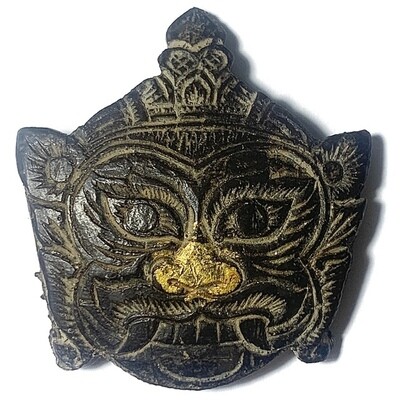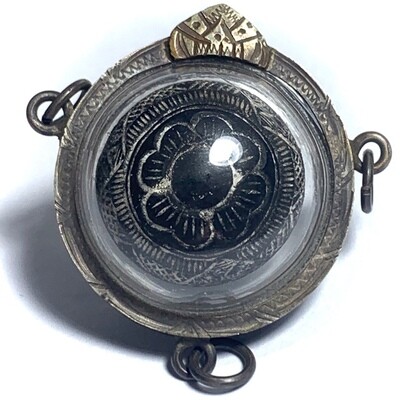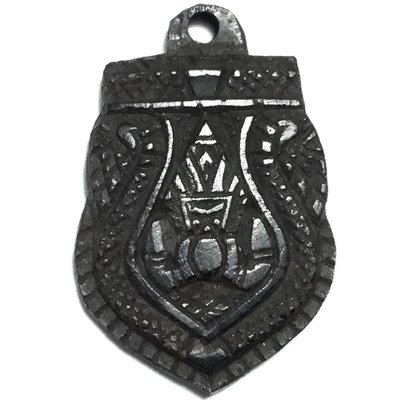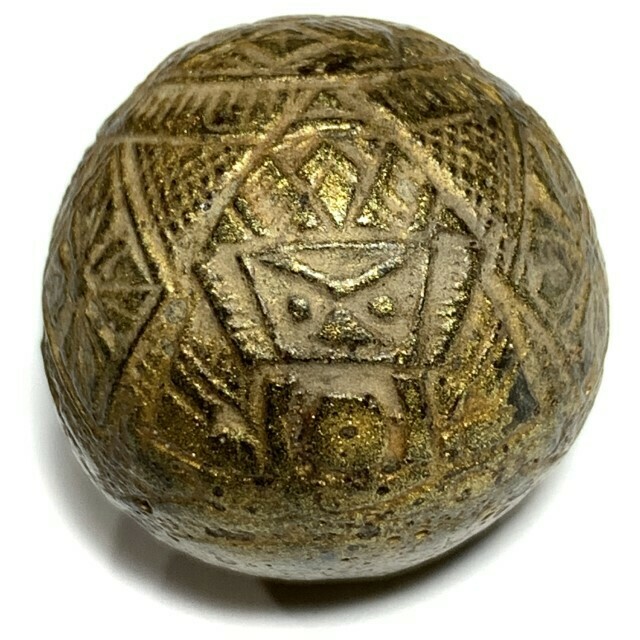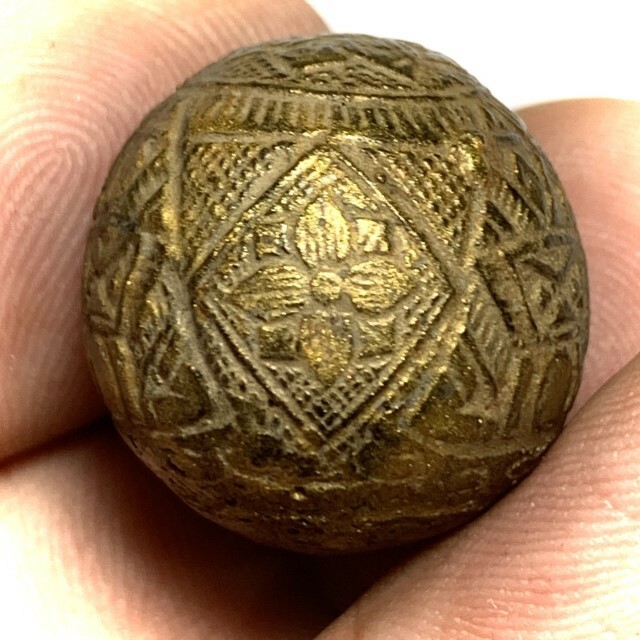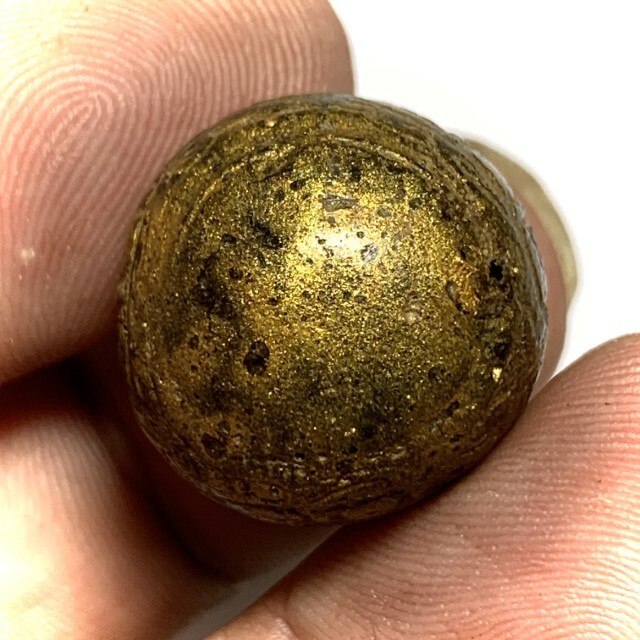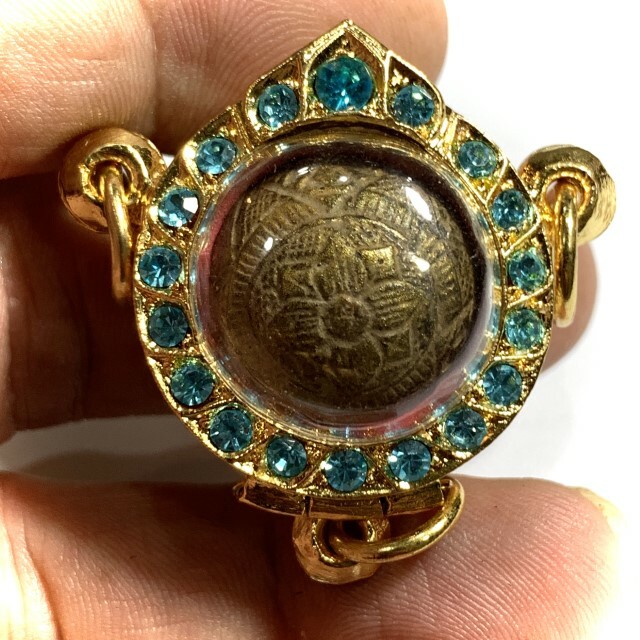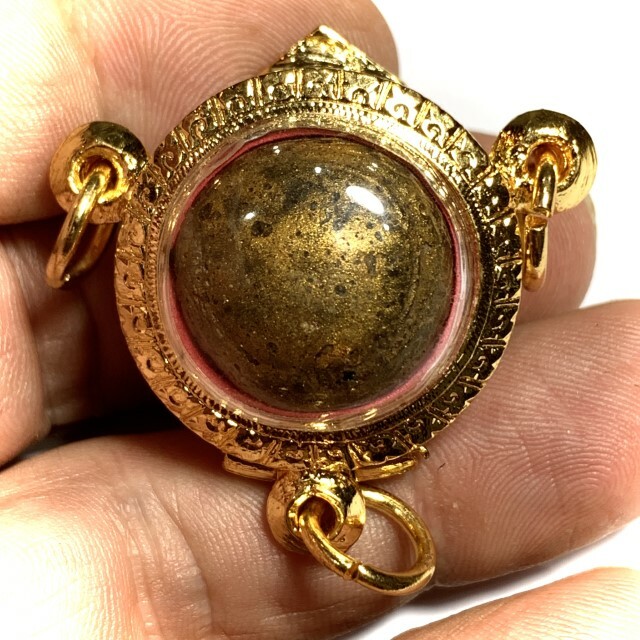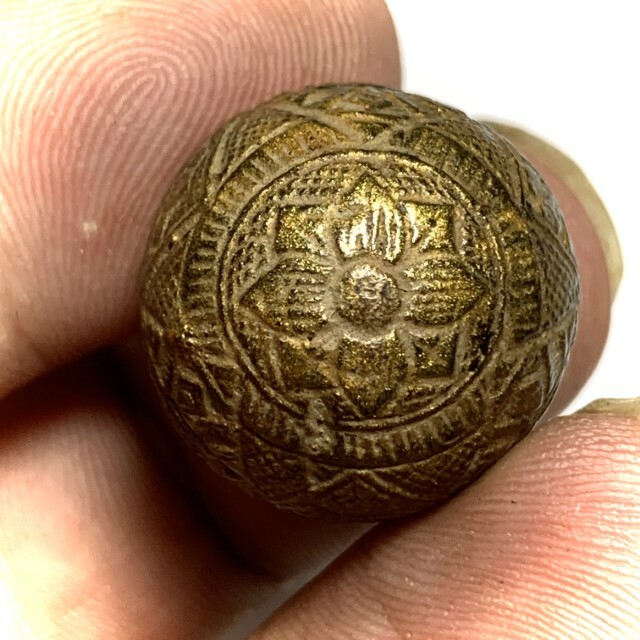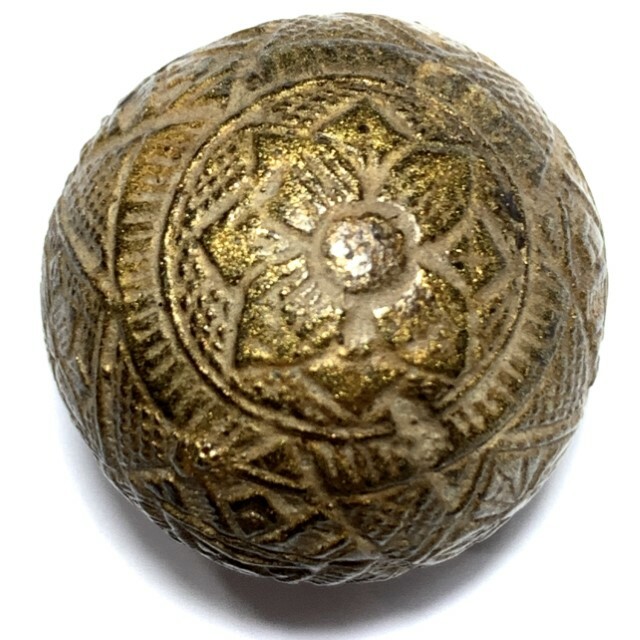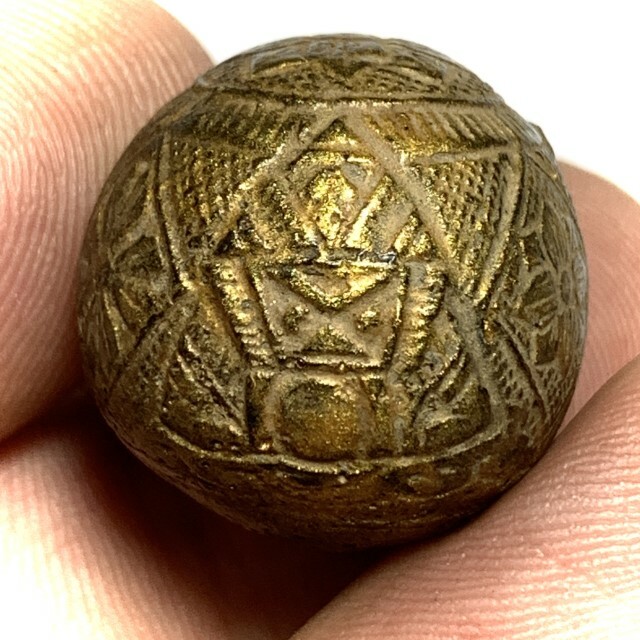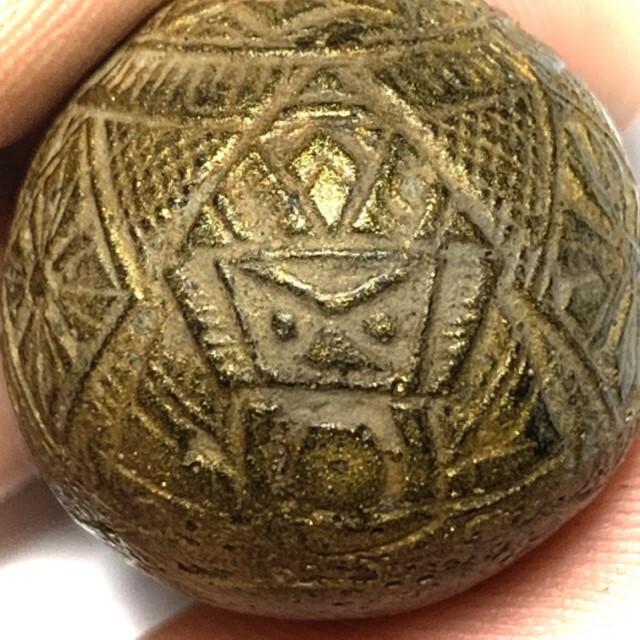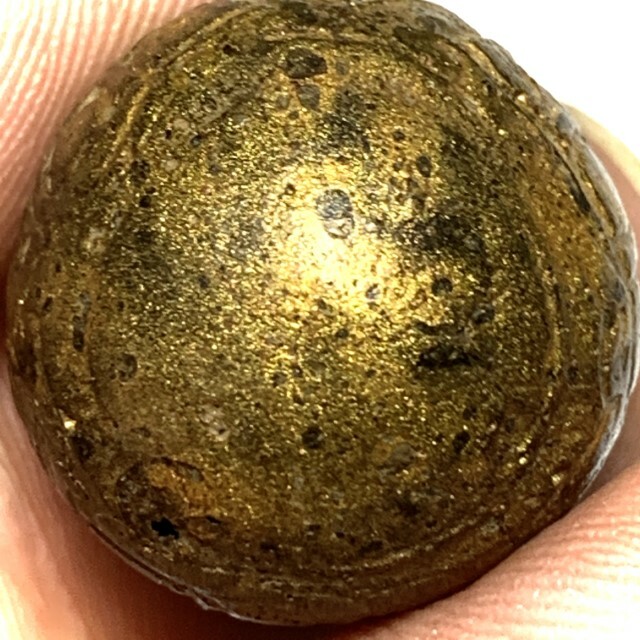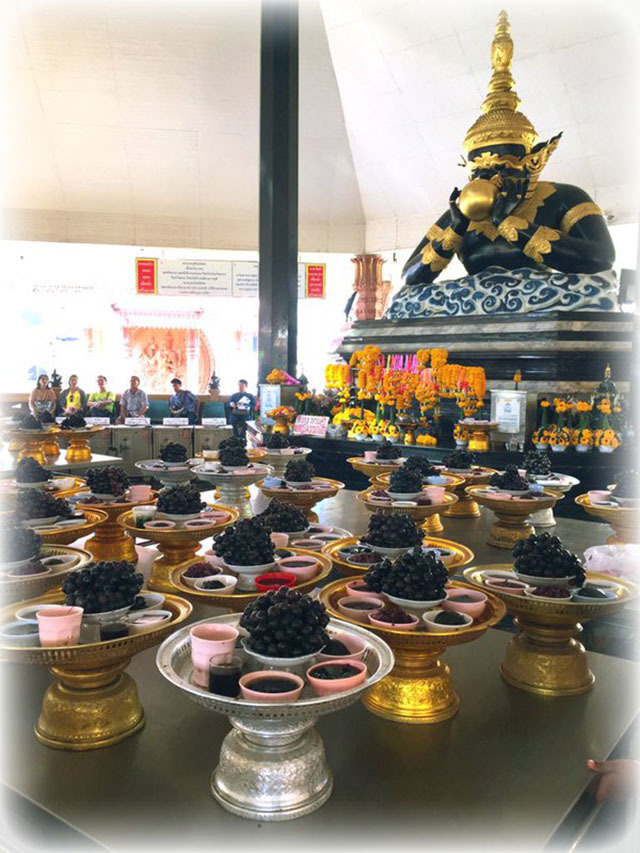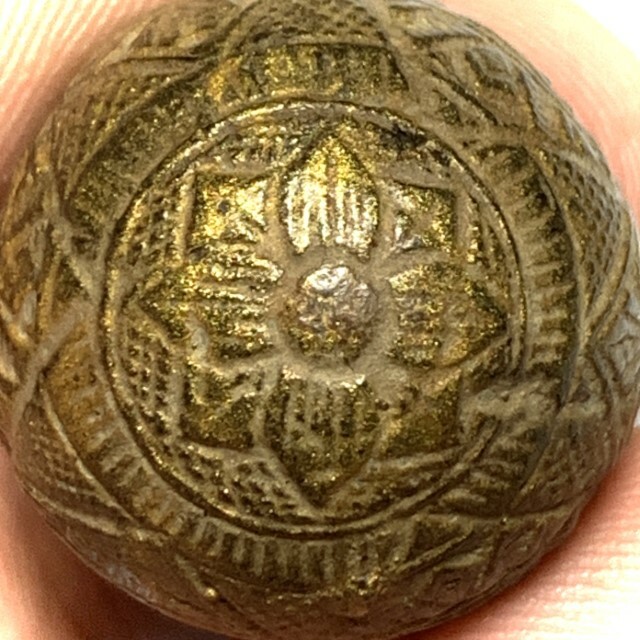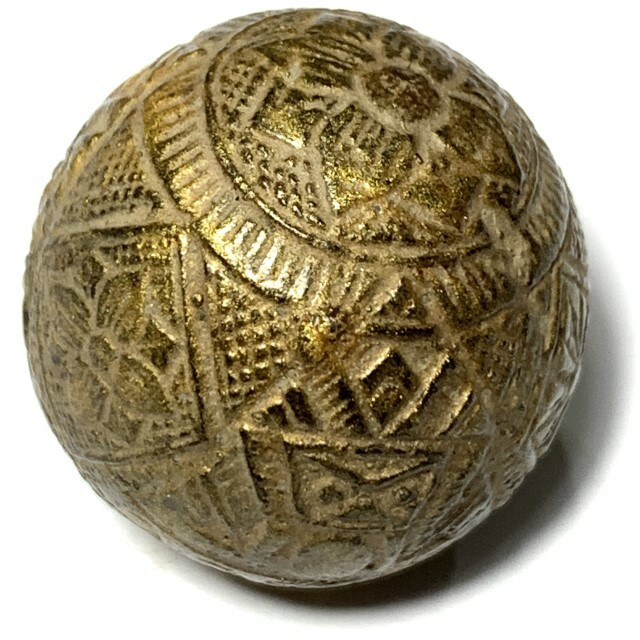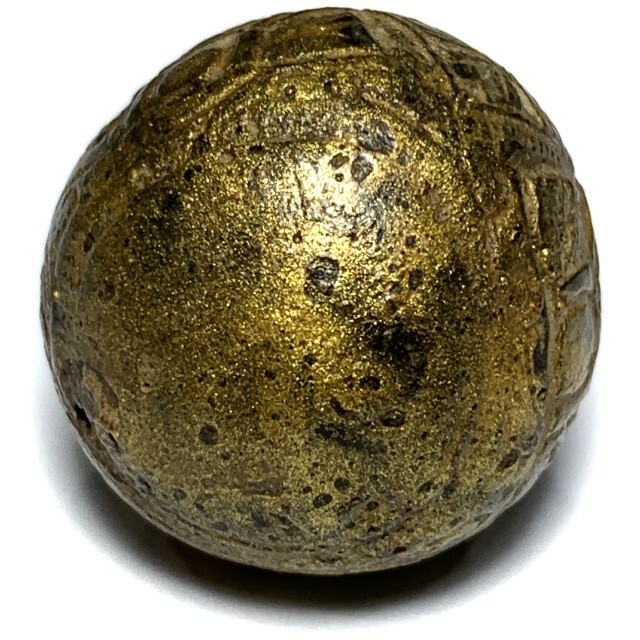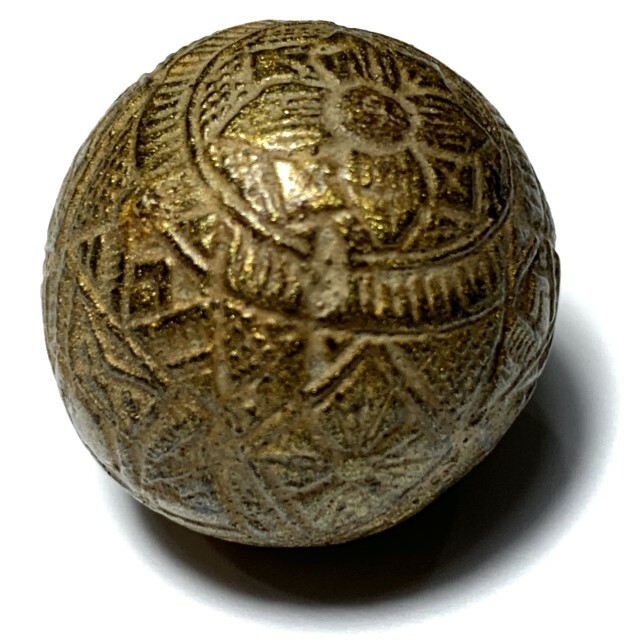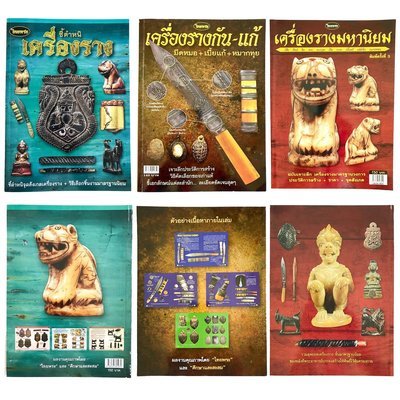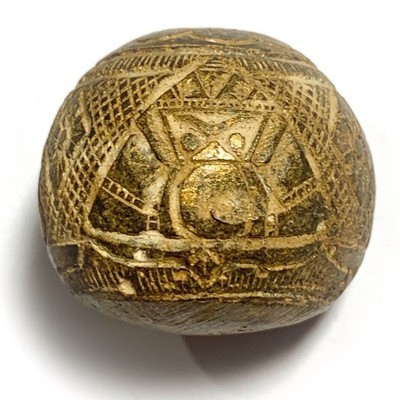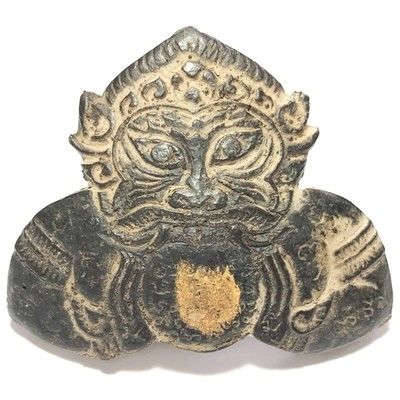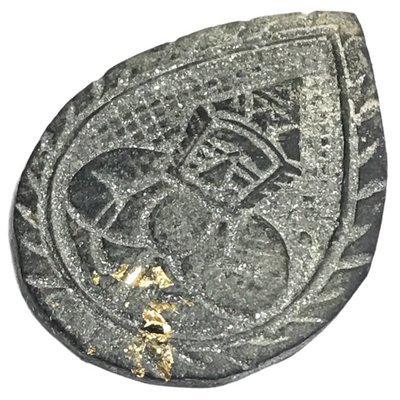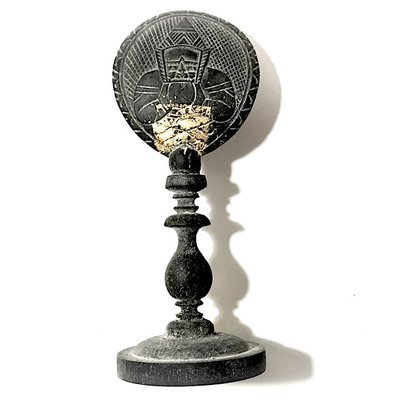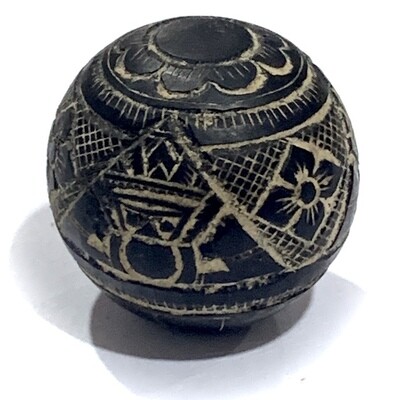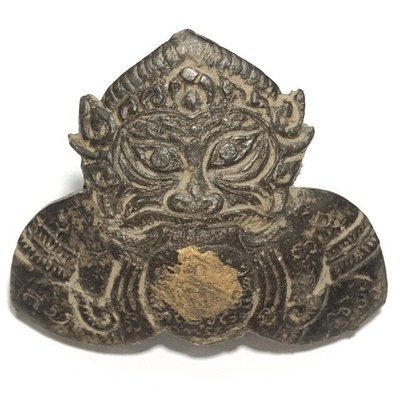Presenting a tiny but powerful and rare classic amulet from one of the Great Khao Or Masters of the 20th Century, Rian Glom Lek Hlang Chedi 2505 BE Nuea Tong Daeng Miniature Guru Monk Coin Por Tan Klai Wajasit
This Sacred amulet of the Great Khao Or Master of Nakorn Sri Tammarat, Master of Wat San Khan and Wat Pratat Noi, is a very rare amulet from Por Tan Klai’s 2505 BE Blessing Ceremony Edition, and is considered a ‘Jaek mae Krua’ type amulet (meaning ‘give to the kitchen maids and temple helpers’), which is suitable not only for men, but due to its miniature size, a perfect amulet for ladies or children to wear.

Rian Glom Lek 2505 BE Por Tan Klai Wajasit Wat Suan Khan
The 2505 BE edition of amulets of Por Tan Klai, is a highly preferred edition, which saw his famous ‘Rian Glom’ round Monk coin amulet with Chakra released, The Rian Glom Lek Hlang Chedi, and the Roop Tai Por Tan Klai Guru Monk Blesséd Photographamulets such as look om chan hmak and ya sen tobacco balls, and sacred powder amulets of various models.
A very rare and highly prized amulet for the devotees of Por Tan Klai to associate with his image and pray to him with a blessed image of the Guru, and the Chedi Relic Stupa on rear face for Buddhanussati and Marananussati. A powerful and Sacred amulet which has passed through the hands of the Guru and been blessed by him.
Por Tan Klai was one of the Top Guru Master Monks of the Last Century, and is considered one of the Four Great Masters of the Previous Generation of Lineage Masters of the Khao Or Southern Sorcery Lineage.
Kata Bucha Por Tan Klai
Kot Kala Phueak Pra Rahu Mai Mee Ta Albino Eyeless Coconut with Kring Bead LP Noi & LP Pin Wat Srisa Tong
Kot Kala Mai Mee Ta eyeless miniature coconut anomaly, hand carved with the Pra Rahu carved Asura Deva God, with Kring Bead insert and gold leaf closure on base. The Kot Kala Phueak Mai Mee Ta is one of the extreme rarities of the amulet pantheon from a highly preferred top masters of Wicha Pra Rahu, Luang Por Pin, and his Mentor and Kroo Ba Ajarn in Magic, LP Noi. of Wat Srisa Tong, in Nakorn Pathom.
A beautifully hand carved miniature eyeless coconut anomaly, in Nuea Kala Phueak albino coconut shell. There are many levels of detail found in the carved Kala Mai Mee Ta of Luang Por Pin and LP Noi, ranging from that of the simple village artisan, to the fine master craftsman.This exhibit is a Kot Kala Mai Mee Ta Phueak, minature self enclosed eyeless coconut shell, and is in very rare albino coconut shell. Although the Kot Kala Mai Mee Ta was released by Luang Por Pin after the passing of Luang Por Noi in the Piti Bucha Kroo Ceremony, it was in fact made and empowered through both Masters over the final era of Luang Por Noi. This can be seen by observing various factors, such as ageing sings, and inscriptions.
The word 'Kot' means 'anomaly'. Eyeless Coconut is even more powerful than one eyed coconut in Thai Magical Belief System. The Albino Eyeless Kot Kala Mini Coconut Anomaly is of course considered perhaps the rarest of all Kot Kala. This amulet comes (as do all) with free registered air parcel shipping worldwide, and a free gift. The Kot Kala amulet is exquisitely carved with Laoatian influenced Buddhist Art eminently visible with the triangular crown worn by Pra Rahu, and other fine details which show the carving was made by one of the Lao Ethnic Artisans who had moved since earlier generations to Nakorn Pathom, and blessed and inscribed with Agkhara.
This amulet is of the size which allows a multitude of forms of casing (extra cost depending on material), and we have the extra option of Gold Micron Bubble Casing with Rhinestones, for those who like a Luxurious Look to their amulet frames. Otherwise you can choose stainless steel, acrylic waterproof, silver plated, solid silver waterproof, or solid gold. This Kot Kala is truly a very rare Ritual Artifact for Wearing as an amulet, or a Mini Bucha for Altar Worship with the World Famous Wicha of Wat Srisa Tong, empowered with the Magic of the preceding Lineage Masters of Wat Srisa Tong; Luang Por Dto, Luang Por Dtrai, Luang Por Dtan, Luang Por Lee, Luang Por Tong, Luang Por Choi, and his Kroo Ba Ajarn Luang Por Noi before him.
The Look Kala Ta Diaw, and Kot Kala Mai Mee Ta and Pra Rahu Sema Glab amulets of Luang Por Pin are for Bucha to Pra Rahu Asura Deva of the Solar and Lunar Eclipse. Tjhis exhibit is carved by a top artisan of Wat Sri Sa Tong, and empowere in ceremony during the eclipses of sun and moon, in Bucha Ceremony at Wat Srisa Tong, with Luang Por Pin, presiding over the Blessing Ceremony.
Luang Por Pin was the Looksit Aek (first and foremost apprentice in Wicha), to the Great Luang Por Noi, previous abbot of Wat Srisa Tong, who bestowed the Wicha onwards to Luang Por Pin in its entirety. The Wicha Pra Rahu Kala Ta Diaw of Wat Srisa Tong is perhaps the most famous of all temples in Thailand, with its lineage of great Guru Master Sorceror-Monks who have practiced this Wicha in lineage transmission since ancient times.
Both Luang Por Noi, and Luang Por Pin enjoy top status for Pra Rahu Kala Ta Diaw amulets, as does the temple of Wat Srisa Tong itself. When we speak of the Pra Rahu Sema Glab amulet in carved coconut shell, one immediately comes to mind with the names of Luang Por Noi, and Luang Por Pin being synonymous. If you feel that your Fate and Horoscope is not Auspicious, then it could be that Pra Rahu is interfering. You can solve this problem by making Bucha offerings to Pra Rahu every Wednesday; Light 10 black incense sticks (‘Toop’ in Thai), and five types of black offerings (e.g. black sticky rice, black jelly grass drink, black semolina or sago pudding and the like).
12 repetitons of the Kata Bucha Pra Rahu are to be Chanted;
Idtipiso Pakawaa Pra Rahuu Sataewaa Samaa Winyaana Idtipiso Pakawaa Putta Sangmi
Below; Magazine from the 1980's showing an example of the Kot Kala of Luang Por Pin, which already carried a price of 8000 Thai Baht half a century ago (circa 280$)
Kata Surya Buppaa (to be chanted in the daylight)
Gusaedto Ma Ma Gusaedto-dto Laalaa Ma Ma Dtolaamo Tolaamo Ma Ma Tolaamo Ma Ma Tolaamodtang Haegudti Ma Ma Haegudti
Kata Jantra Bupaa (to be chanted in the night time)
Yadt-thadtang Ma Ma Dtangthaya Dtawadtang Mamadtang Wadtidtang Saegaa Ma Ma Gaasaegang Gaadtiyang Ma Ma.Gaadtiyang Ma Ma Yadtigaa
When you begin to Bucha Rahu Deity, you should make the first ever session in the evening of a Wednesday (any time from 7 pm onwards). After you have done this once, you can make Bucha in the daytime if you wish, but the first time you must include the food offerings of black foods as well as the black incense. The second time onwards, only the incense is necessary in the daytime, if it is a lot of trouble to get the food offerings. The Pra Rahu Kala Ta Diaw of Luang Phu Noi and Luang Por Pin, are the most prestigious of all in the eyes of the Pra Niyom Collector Community, with the exception of the Great Lanna Master Kroo Ba Nanta of Wat Tung Man Dtai
The Rahu amulets of Wat Srisa Tong themselves were made by Artisans, who were devoted Looksit of Luang Por Noi, who were mostly immigrants from Vientiane, in Laos, who moved to Thailand during the early Ratanakosin Period of Thai History. Luang Por would then would distribute them back to the devotees for protection and Serm Duang (improve fate and destiny).
As the Lao artisans began to develop their skills and experience repeatedly carving the coconut shells, the design became ever more finely tuned and increasing in beauty, but due to the fact that there were a large number of artisans all making these carvings, the designs would be varied both in appearance of features, and in the quality and amount of detail.
Wat Srisa Tong
As the earthen foundations of the temple of Wat Srisa Tong were being dug for the building of the temple, a golden Buddha Head was discovered, and because of this, the Temple was first given the name 'Wat Hua Tong' which means 'Temple of the Golden Head'. The word 'Hua' means 'head' in colloquial Thai, but for referring to a Sacred Image of a Deity or a Buddha (or a Monk), the word 'Srisa', which also means 'Head', in high speech, is preferred. So the name was then changed later to 'Wat Srisa Tong'.
The first Abbot of the temple was Luang Por Dto, who was one of the Laoatian people who had immigrated from Vientiane. Luang Por Dtrai developed the temple continually. The Lao people who built the temple had many artisan who knew that Luang Por Dtrai had powerful Wicha Akom and the sectrets of the Laoatian Wicha Pra Rahu Om Jantr, and so they carved Rahu Amulets from one eyed coconut shells using the traditional Lao Artistic style, to give to Luang Por Dtrai for empowerment.
Over the years, Wat Srisa Tong grew constantly throughout the lineage of Abbots, from a small temple into a large impressive temple over the years. After Luang Por Dtrai's passing, he was succeeded by the new Abbot, Luang Por Dtan, who was succeeded by Luang Por Lee, who was then succeeded by Luang Por Tong, after which came Luang Por Choi, and then cam the fifth Abbot, Luang Por Noi Kantachodto.
It was the second Abbot, Luang Por Lee, who inherited and continued the Wicha Pra Rahu Om Jantr in the Lao tradition from Luang Por Dtrai. Luang Por Noi was also one of the Lao People of Srisa Tong municipality in Nakorn Chaysri, who during his time as a Buddhist Monk before becoming Abbot, was practicing at Wat Srisa Tong, and learned the Wicha of Luang Por Dtrai from Luang Por Lee, and ascended later to become the next Master Adept. This adepthood was supported by a strong foundation in the Wicha Pra Rahu Om Jantr from Luang Por Noi's Father, who was also a Laymaster of Lao Sorcery too, and who made carved Rahu amulets and empowered them.
So Luang Por Noi got to learn this Wicha from his Father from a very early age, and this made him the perfect apprentice for Luang Por Lee to pass on his Wicha of the Pra Rahu Om Jantr Kala Ta Diaw. Luang Por Noi brought the Wicha Pra Rahu Om Jantr Gae Kala Ta Diaw begun by Luang Por Dtrai, passed to him through Luang Por Lee, to World Fame, through his higher development of the artistic features of the artisanry and design of the carved coconut shell images.
Below; Luang Por Noi- Kroo Ba Ajarn of Luang Por Pin
Luang Por Noi did this by raising a more stringent rule for the magical requirements in allowing only coconuts with one single eye to be used for the carving of the Rahu image. Luang Por Noi then passed on in turn all of his accumulated knowledge and prowess and the secrets of empowerment of the Pra Rahu Kala Ta Diaw, to Luang Por Pin. It is then with Luang Por Pin that the Wicha Pra Rahu Kala Ta Diaw was given to preserve and continue. Luang Por Pin then became the Master of the Wicha after the Passing of Luang Por Noi.
Below; Luang Por Pin
The Wicha continued on with the next abbot Luang Por Manich, which also passed away now in 2559 BE. We await the appearance of the next Master of the Wicha Rahu of Wat Srisa Tong, and hope to find and present as many examples of the amulets of this lineage as we can over the coming years, to collect and admire.
